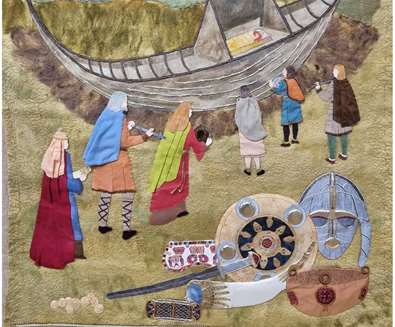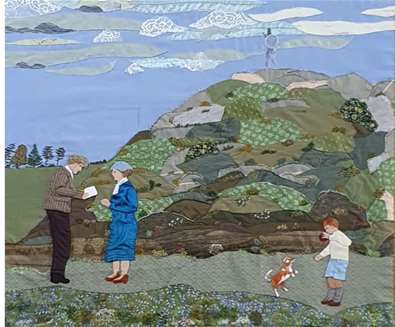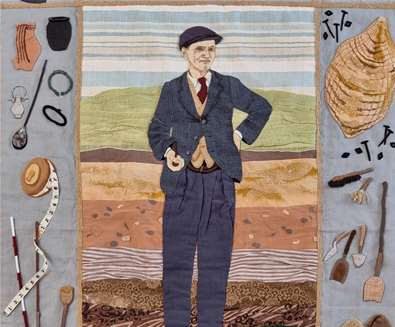Discover the fascinating stories of three partnerships involving strong women – two of them much less famous than their husbands, at a fascinating exhibition of 20 tapestries depicting the story of Sutton Hoo at The Longshed in Woodbridge.
King Raedwald and his Queen

Sadly, she is nameless; even the Venerable Bede did not name her. But we can be sure that she had influence over the King. It is believed that the famous mound at Sutton Hoo is the burial site of this once-powerful Anglo-Saxon king. What is less well known is that Raedwald’s queen may have arranged the event, using it to demonstrate her and her family’s power and social standing as well as a homage to her husband. We know that the contents of the burial chamber contained a wealth of precious regalia and ornaments, but it also contained spare shoes, clean linen and a shaving kit.
Bede’s depiction of the Queen was ambiguous. On the one hand, a pagan herself, she is thought to have persuaded Raedwald to revert back from Christianity to paganism, thus casting her as a malign seductress, steering him in the wrong direction. On the other hand, she is praised for giving Raedwald sound advice in persuading him not to kill his good friend Edwin of Northumbria, thereby saving his honour and kingship.
Edith & Frank Pretty

Approximately 1200 years later, in Yorkshire, Edith Dempster was born. During World War I, Edith worked for the Red Cross and helped to house Belgian Refugees. On her eighteenth birthday she received a marriage proposal from Frank Pretty of Ipswich who served as a major in the Suffolk Regiment. The pair corresponded during the war but it wasn’t until 1926 that the marriage took place.
Edith gave birth to a son, Robert, in 1930. Sadly, her husband Frank died just four years later. The story of her purchase of the Sutton Hoo estate and her determination to uncover what was buried in the mounds is now well-known as is her enormous generosity in donating the archaeological finds to the British Museum. Edith Pretty died in 1942. A strong woman indeed.
Basil and Dorothy 'May' Brown

Our third Valentine couple is Basil and Dorothy ‘May’ Brown. Basil was a self-taught amateur, and later professional, archaeologist who was invited by Edith Pretty to excavate the mounds at Sutton Hoo in 1938. He famously made the discovery of a lifetime in 1939 when he brushed away the Suffolk soil and revealed the richest intact early medieval grave in Europe.
Basil and May married in 1923 and worked on the family farm where May took responsibility for the dairy. But Basil’s interests lay elsewhere and the farm became unviable so the couple moved to a rented cottage in 1935.
As Basil cycled away to his work at Sutton Hoo 35 miles away, little did May know that he was about to make history. He lodged with Edith Pretty’s chauffeur during the week and cycled back to the cottage at weekends. They were a devoted couple and May was fiercely proud of his achievements. He wrote almost daily letters, sometimes bemoaning the fact that he had ‘no real news’. May encouraged him and hoped that he would ‘come across something really good and uncommon’. She wrote to Edith Pretty thanking her for giving Basil the opportunity to work on the dig. She must have felt his sidelining by the ‘experts’ very keenly.